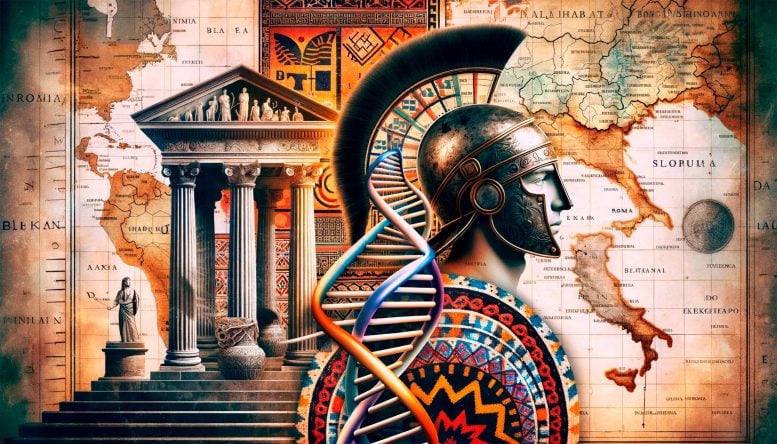
An international research team has uncovered the complex genomic history of the Balkan Peninsula during the Roman era and beyond, revealing a mix of Anatolian and Slavic influences. The study, combining ancient DNA analysis with historical and archaeological data, shows how migrations and the Roman Empire’s policies have shaped the genetic makeup of modern Balkan populations. Credit: SciTechDaily.com
A multidisciplinary study reveals the Balkan Peninsula’s genomic history, highlighting the profound impact of Anatolian and Slavic migrations during and after the Roman Empire. This research underscores the shared demographic history across the Balkans.
A multidisciplinary study led by the Institute of Evolutionary Biology in Spain (a joint center of the Spanish National Research Council and Pompeu Fabra University), the University of Belgrade in Serbia, the University of Western Ontario in Canada, and Harvard University in the USA, reconstructs the genomic history of the Balkan Peninsula during the first millennium of the common era, a time and place of profound demographic, cultural and linguistic change.
The team has recovered and analyzed whole genome data from 146 ancient people excavated primarily from Serbia and Croatia—more than a third of which came from the Roman military frontier at the massive archaeological site of Viminacium in Serbia—which they co-analyzed with data from the rest of the Balkans and nearby regions.
The work, published in the journal Cell, highlights the cosmopolitanism of the Roman frontier and the long-term consequences of migrations that accompanied the breakdown of Roman control, including the arrival of people speaking Slavic languages. Archaeological DNA reveals that despite nation-state boundaries that divide them, populations in the Balkans have been shaped by shared demographic processes.
Massive demographic influx into the Balkans from the East during the Roman Empire – largely from the eastern Mediterranean and even from East Africa.
After Rome occupied the Balkans it turned this border region into a crossroads, one that would eventually give rise to 26 Roman Emperors, including Constantine the Great who shifted the capital of the empire to the eastern Balkans when he founded the city of Constantinople.
The team’s analysis of ancient DNA shows that during the period of Roman control, there was a large demographic contribution of people of Anatolian descent that left a long-term genetic imprint in the Balkans. This ancestry shift is very similar to what a previous study showed happened in the megacity of Rome itself—the original core of the empire—but it is remarkable that this also occurred at the Roman Empire’s periphery.
A particular surprise is that there is no evidence of a genetic impact on the Balkans of migrants of Italic descent: “During the Imperial period, we detect an influx of Anatolian ancestry in the Balkans and not that of populations descending from the people of Italy,” says Íñigo Olalde, Ikerbasque researcher at the University of the Basque Country (UPV/EHU) and co-lead author of the study. “These Anatolians were intensively integrated into local society. At Viminacium, for example, there is an exceptionally rich sarcophagus in which we find a man of local descent and a woman of Anatolian descent buried together.”
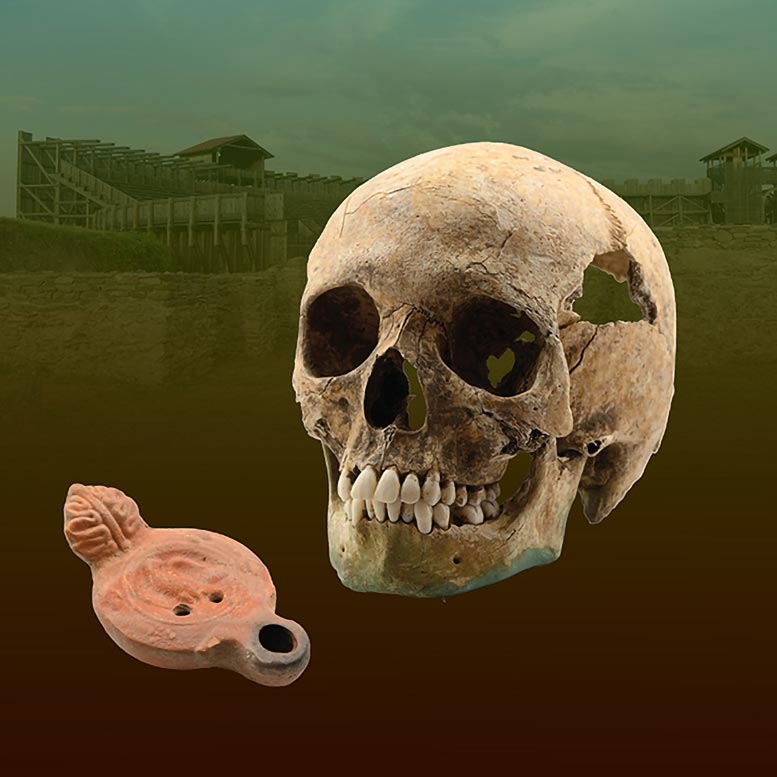
Skull of an individual of East African ancestral origin found in Viminacium, with the oil lamp featuring an eagle found in his tomb. Credit: Miodrag (Mike) Grbic
The team also discovered cases of sporadic long-distance mobility from far-away regions, such as an adolescent boy whose ancestral genetic signature most closely matches the region of Sudan in sub-Saharan Africa and whose childhood diet was very different from the rest of the individuals analyzed. He died in the 2nd century CE and was buried with an oil lamp representing an iconography of the eagle related to Jupiter, one of the most important gods for the Romans.
“We don’t know if he was a soldier, slave or merchant, but the genetic analysis of his burial reveals that he probably spent his early years in the region of present-day Sudan, outside the limits of the Empire, and then followed a long journey that ended with his death at Viminacium (present-day Serbia), on the northern frontier of the Empire,” says Carles Lalueza-Fox, principal investigator at the Institute of Evolutionary Biology (IBE) and director of the Museum of Natural Sciences of Barcelona (MCNB).
“Archaeogenetics is an indispensable complement to archaeological and historical evidence. A new and much richer picture comes into view when we synthesize written records, archaeological remains like grave goods and human skeletons, and ancient genomes,” says co-author Kyle Harper, a historian of the ancient Roman world at the University of Oklahoma.
The Roman Empire incorporated “barbarian” peoples long before its collapse.
The study identified individuals of mixed Northern European and Pontic steppe descent in the Balkans from the 3rd century, long predating the final breakdown of Roman imperial control. Anthropological analysis of their skulls shows that some of them were artificially deformed, a custom typical of some populations of the steppes including groups labeled by ancient authors as “Huns.”
These results reflect the integration of people from beyond the Danube into Balkan society, centuries before the fall of the Empire.
“The borders of the Roman Empire differed from the borders of today’s nation-states. The Danube served as the geographic and military boundary of the Empire. But it also acted as a crucial communication corridor that was permeable to the movement of people attracted by the wealth Rome invested in its frontier zone,” says co-author Michael McCormick, Francis Goelet Professor of Medieval History at Harvard University.
Slavic populations changed the demographic composition of the Balkans.
The Roman Empire permanently lost control of the Balkans in the sixth century, and the study reveals the subsequent large-scale arrival in the Balkans of individuals genetically similar to the modern Slavic-speaking populations of Eastern Europe. Their genetic fingerprint accounts for 30-60% of the ancestry of today’s Balkan peoples, representing one of the largest permanent demographic shifts anywhere in Europe in the early medieval period.
The study is the first to detect the sporadic arrival of individual migrants who long preceded later population movements, such as a woman of Eastern European descent buried in a high imperial cemetery. Then, from the 6th century onwards, migrants from Eastern Europe are observed in larger numbers; as in Anglo-Saxon England, the population changes in this region were at the extreme high end of what occurred in Europe and were accompanied by language shifts. “According to our ancient DNA analysis, this arrival of Slavic-speaking populations in the Balkans took place over several generations and involved entire family groups including both men and women,” explains Pablo Carrión, researcher at the Institute of Evolutionary Biology and co-lead author of the study.
The establishment of Slavic populations in the Balkans was greatest in the north, with a genetic contribution of 50-60% in present-day Serbia, and gradually less towards the south, with 30-40% in mainland Greece and up to 20% in the Aegean islands. “The major genetic impact of Slavic migrations is visible not only in current Balkan Slavic-speaking populations, but also in places that today do not speak Slavic languages such as Romania and Greece,” says co-senior author David Reich, professor of genetics in the Blavatnik Institute at Harvard Medical School and professor of human evolutionary biology in Harvard’s Faculty of Arts and Sciences.
Bringing together historians, archaeologists, and geneticists.
The study involved an interdisciplinary collaboration of over 70 researchers, including archaeologists who excavated the sites, anthropologists, historians and geneticists.
“This work exemplifies how genomic data can be useful for getting beyond contentious debates around identity and ancestry that have been inspired by historical narratives rooted in nascent nineteenth-century nationalisms and that have contributed to conflict in the past,” says Lalueza-Fox. The team also generated genomic data from diverse present-day Serbs that could be compared with ancient genomes and other present-day groups from the region.
“We found there was no genomic database of modern Serbs. We therefore sampled people who self-identified as Serbs on the basis of shared cultural traits, even if they lived in different countries such as Serbia, Croatia, Montenegro or North Macedonia,” says coauthor Miodrag Grbic, Professor at the University of Western Ontario, Canada.
Co-analyzing the data with that of other modern people in the region, as well as the ancient individuals, shows that the genomes of the Croats and Serbs are very similar, reflecting shared heritage with similar proportions of Slavic and local Balkan ancestry.
“Ancient DNA analysis can contribute, when analyzed together with archaeological data and historical records, to a richer understanding of the history of Balkans history,” says Grbic. “The picture that emerges is not of division, but of shared history. The people of the Iron Age throughout the Balkans were similarly impacted by migration during the time of the Roman Empire, and by Slavic migration later on. Together, these influences resulted in the genetic profile of the modern Balkans—regardless of national boundaries.”
For more on this research:
Reference: “A genetic history of the Balkans from Roman frontier to Slavic migrations” by Iñigo Olalde, Pablo Carrión, Ilija Mikić, Nadin Rohland, Swapan Mallick, Iosif Lazaridis, Matthew Mah, Miomir Korać, Snežana Golubović, Sofija Petković, Nataša Miladinović-Radmilović, Dragana Vulović, Timka Alihodžić, Abigail Ash, Miriam Baeta, Juraj Bartík, Željka Bedić, Maja Bilić, Clive Bonsall, Maja Bunčić, Domagoj Bužanić, Mario Carić, Lea Čataj, Mirna Cvetko, Ivan Drnić, Anita Dugonjić, Ana Đukić, Ksenija Đukić, Zdeněk Farkaš, Pavol Jelínek, Marija Jovanovic, Iva Kaić, Hrvoje Kalafatić, Marijana Krmpotić, Siniša Krznar, Tino Leleković, Marian M. de Pancorbo, Vinka Matijević, Branka Milošević Zakić, Anna J. Osterholtz, Julianne M. Paige, Dinko Tresić Pavičić, Zrinka Premužić, Petra Rajić Šikanjić, Anita Rapan Papeša, Lujana Paraman, Mirjana Sanader, Ivana Radovanović, Mirjana Roksandic, Alena Šefčáková, Sofia Stefanović, Maria Teschler-Nicola, Domagoj Tončinić, Brina Zagorc, Kim Callan, Francesca Candilio, Olivia Cheronet, Daniel Fernandes, Aisling Kearns, Ann Marie Lawson, Kirsten Mandl, Anna Wagner, Fatma Zalzala, Anna Zettl, Željko Tomanović, Dušan Keckarević, Mario Novak, Kyle Harper, Michael McCormick, Ron Pinhasi, Miodrag Grbić, Carles Lalueza-Fox and David Reich, 7 December 2023, Cell.
DOI: 10.1016/j.cell.2023.10.018

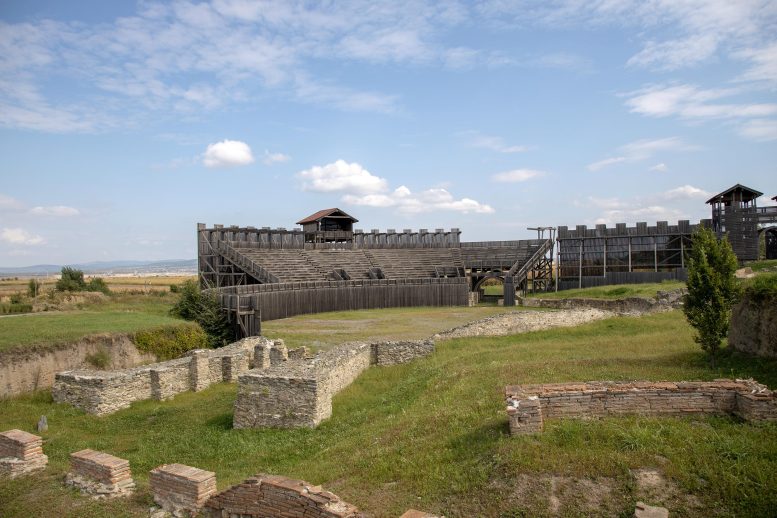
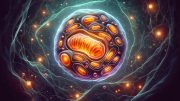



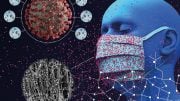


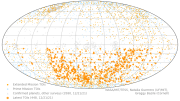
I have to say a few things about the text above, I didn’t reveal my nickname before.I am locally known as Alexir.Of course, we changed several houses and these were all the work of the Lords of the Earth.You should know that I will explain in a way that I will explain later.With evidence, evidence and documents, I am truly the guardian of the time and the special representative of the lords of the earth.I have a number of accounts.I will not repeat what Salman Rashti did.He may have been right, but I consider caution as the first condition.Maybe I, and after me, my book.It is very likely that my supporters will bring this issue to light.This is very, very important.The law of God will be implemented and the religions that will be rejected are the orders of the Lords of the world.Whether it will be implemented by me, or God and other Gods will implement the new law of religions, or God will implement the new law.bring religions to the fore by the savior and his messenger, it doesn’t matter if wise people issue a law that old religions are abandoned, in any case, this matter will be realized, let’s pass this issue, I want to explain the wordQayyim Qayyim is a word that has several meanings and it was determined by God and the Lords of the world.Send me a message.I don’t know the weapon.I need to give an address.My duty is to inform about the history of humans on earth and the fate of humans on earth, and I have a duty on my part to tell the facts that happened on earth to the world and especially to Believers and Muslims of Iran, I mustbring the word of truth and what has been assigned to me to appear, God willing, this essay and the dictation of God is also the same word, God willing, I want the translation to translate the word God willing like Farsi, and if possible, the word religions Of course, this may not be possible in translation